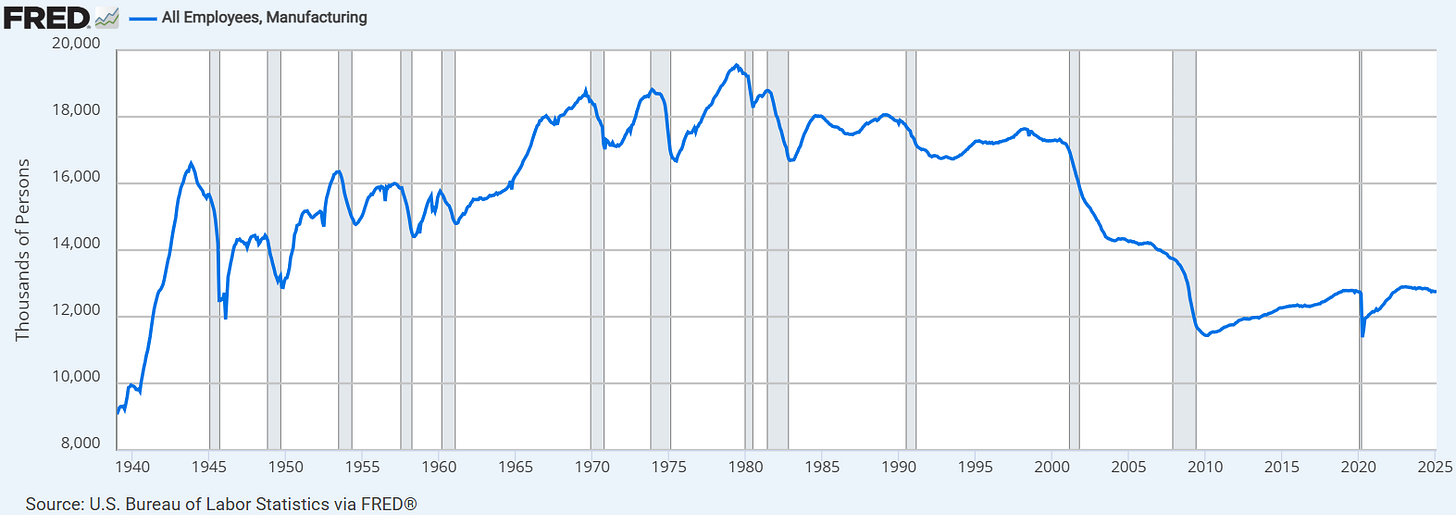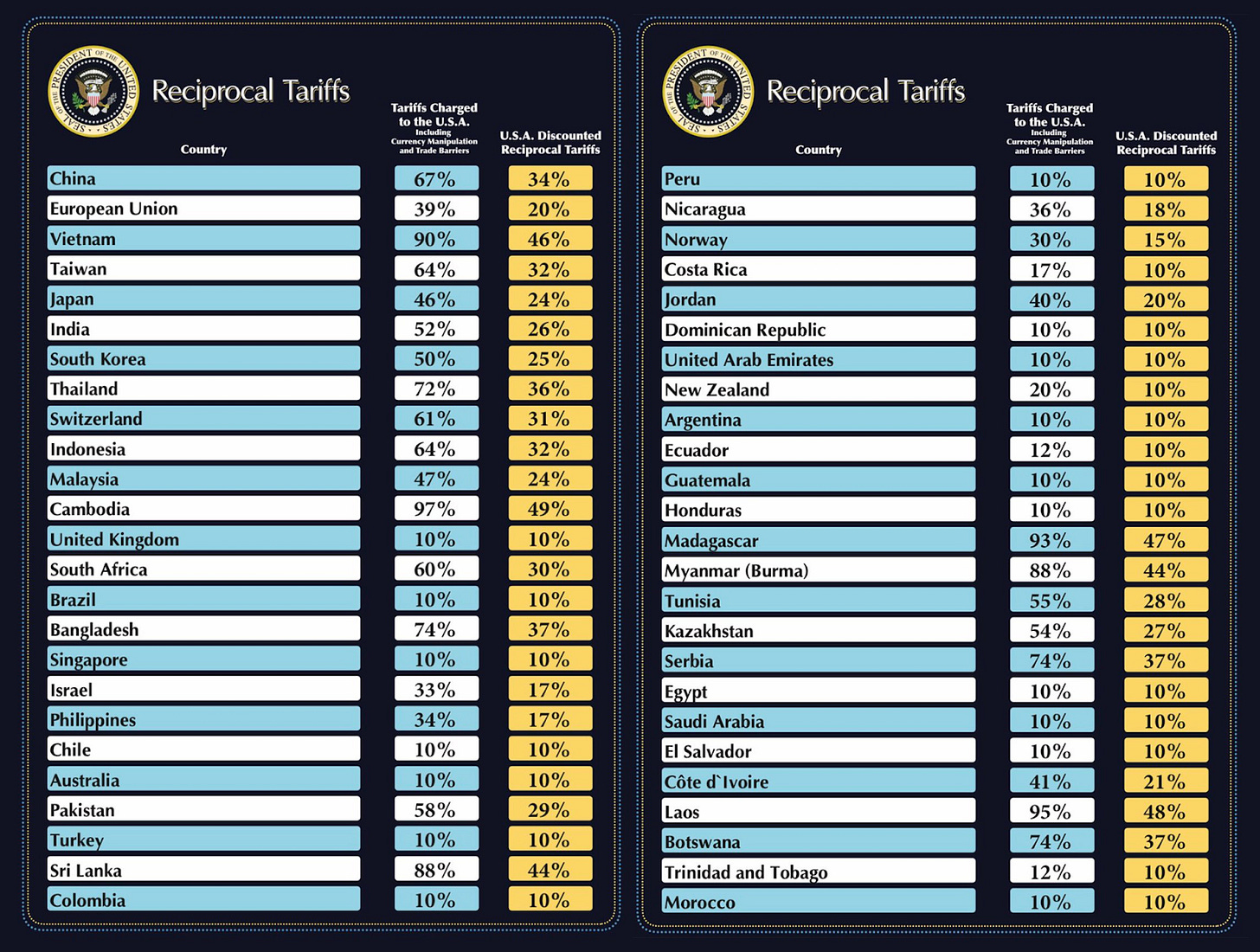A New Economic Era: Trump Initiates Most Aggressive Tariffs Since WWII
A more human way to engage with the news...and life.
+ GetSmart: how traffic jams form 🚗🚗🚗
P.S. Want a News Memo hoodie?
Send us a screenshot of a text or email sharing the News Memo with a friend and your name will be put in a drawing for a free sweatshirt. The winner will be announced next week.
Send screenshots to john@thenewsmemo.com
Newsbites
Chart of the week: Manufacturing jobs in the U.S. have declined from a peak of 19.5M in 1979 to about 12.5M today (35% decrease).
JFK files hearing: A House Task Force heard testimony from multiple JFK researchers this week, including Oliver Stone and Jefferson Morley. Stone and Morley highlighted new revelations from the March 18 release of JFK files, including that James Jesus Angleton (high-ranking official of the CIA at the time) lied to the House Select Committee in 1978 (clip). In addition, Mr. Morley said the CIA continues to withhold certain files, including the personnel profile of George Joannides, who was another high-ranking CIA agent in the 1960s (clip).
More: Stone, an influential filmmaker, called for Congress to reopen the investigation into JFK’s assassination (the last Congressional investigation into the matter ended in 1978).
Stocks suffered their largest single-day drop on Thursday since 2020 after Trump announced massive tariffs on virtually all of America’s trading partners. The Nasdaq was down 6%, the S&P 500 tumbled nearly 5%, and the Dow slid 4% (more in the main story below).
More federal layoffs: The Department of Health and Human Services announced layoffs for more than 10,000 employees this week in a new effort to reorganize the department. “This overhaul is about realigning HHS with its core mission: to stop the chronic disease epidemic and Make America Healthy Again,” Kennedy Jr. said. The cuts have caused some disruption, including the layoffs of several lead members in Milwaukee addressing lead contamination in schools. When asked about that particular instance, Kennedy said, “There are some programs that were cut that are being reinstated, and I think that’s one of them.” (video)
Cory Booker (Democratic Senator, NJ) spoke for 25 hours and 5 minutes straight on the Senate floor on Tuesday, breaking the previous record set in 1957. Booker, who stood, never went to the bathroom, and didn’t eat during the entire speech, primarily criticized the Trump administration (video).
Controversial deportations: The Trump Administration is facing criticism for some of its deportation practices, such as sending suspected gang members to the harsh maximum security prison in El Salvador. In one case, a man named Andry Jose Hernandez Romero, 31, was put on a plane to El Salvador supposedly for having a tattoo common among Tren de Aragua gang members. Friends and family of Romero say he is not a part of the gang and that he did not receive due process. The Administration says they have more evidence than the tattoo. In another instance, ICE said it made an “administrative error” when it sent Kilmar Abrego Garcia to El Salvador’s CECOT prison. Abrego Garcia’s case has attracted significant attention and calls for the White House to bring him back to the U.S., which hasn’t happened. Journalists on X attacked VP JD Vance over the incident as well.
The Wisconsin Supreme Court election, which drew national attention and millions of dollars, was held on Tuesday, April 1. Democrat-backed candidate Susan Crawford beat the former Attorney General of the State, Brad Schimel, giving liberal justices a majority in the state Supreme Court. Elon Musk visited Wisconsin on Sunday night to hold a last-minute rally for Schimel, whom he branded “Super Judge Schimel.” Federal judges have slowed Trump’s policies and have increasingly been called “activists” by Trump and Musk.
More: Wisconsin also enshrined a voter-ID law into the constitution.
A New Economic Era: Trump Initiates Most Aggressive Tariffs Since WWII
What happened?
Speaking from the White House lawn on Wednesday in what he called “Liberation Day,” President Trump announced aggressive tariffs on more than 50 countries (video). The tariffs range from 20% for the European Union, 34% for China, 26% for India, 24% for Japan, and 46% for Vietnam (list).
For the countries that did not receive a specific rate, a 10% baseline tariff will go into effect. In addition, Trump reiterated the previously announced 25% tariff for imported automobiles. Mexico and Canada were not included in Wednesday’s announcement given the previous rounds of tariffs.
Explainer: A tariff is a tax paid to the government by a business that imports goods from a foreign country. For example, GM pays tariffs on the parts it imports from Mexico to manufacture vehicles.
The changes are the clearest indication yet that Trump appears set on ushering in a new paradigm of U.S. economic policy, which has been marked by globalization since about 1950. The magnitude of the shift has the potential to disrupt and shape new geopolitical and economic alliances.
Financial markets dropped sharply on Thursday, with the S&P 500 falling 5% and the Nasdaq falling 6% (the largest single-day drop since covid in 2020).
Which goods will be most affected?
The top five categories of imported goods in the U.S. are machinery products, electronics, automobiles, energy products, and pharmaceuticals.
The largest shift in economic policy since WWII
Trump is trying to upend the economic consensus that has endured for some 70 years. Since 1947, when the U.S., along with 22 other countries established the General Agreement on Tariffs and Trade (which later became the World Trade Organization), until today, the general policy has been free trade and low/no tariffs.
In short, he is trying to reverse the trend of globalization, which greatly accelerated when China and other East Asian countries opened up their economies in the 1980s. During this period, the U.S. outsourced a large percentage of manufacturing and other industrial production to foreign countries.
Trump has been saying for decades that he feels the U.S. is being untreated fairly by other countries, which generally have more trade barriers and higher tariffs against the U.S. (video clip from 1988 of Trump on Oprah Winfrey). In 1988, as well as today, Trump said he does not blame the foreign countries for these practices, but blames U.S. presidents who have allowed them to continue.
On top of wanting to bring more manufacturing back to the U.S., Trump also thinks tariffs are a good source of tax revenue. He has often pointed out that before the personal income tax was introduced in 1913, the U.S. government’s primary source of revenue was tariffs.
Go deeper: Howard Lutnick, the U.S. Secretary of Commerce, discusses Trump’s economic policy and the role of tariffs on the All-In Podcast (Spotify) (YouTube). Tariff discussion starts at the 52-minute mark of the podcast.
How were the tariff rates determined?
President Trump said he had his team estimate a “blended” tariff rate that each country is currently charging the U.S., which included the explicit tariff rate, while also factoring in currency manipulation and other trade barriers that countries have in place. In return, Trump said the U.S. would impose tariff rates at half what other countries are charging the U.S.
However, accounts on X offered another theory on how the tariff rates were determined: by simply dividing the U.S. trade deficit with each country by the country’s total exports to the U.S. The calculation closely mirrors the posted tariff rates.
What are the arguments for tariffs?
Protect Domestic Industries: All things equal, tariffs make imported goods more expensive, incentivizing businesses to build more things domestically. This, in turn, is hoped to increase jobs and wages in the U.S.
Raise Government Revenue: Tariffs bring in tax revenue for the government outside of income and payroll taxes.
National Security: Tariffs can reduce reliance on foreign countries for essential goods, such as food, computer chips, medicine, energy, and defense.
What are the arguments against tariffs?
Higher Consumer Prices: Tariffs increase the cost of imported goods, thereby raising prices for consumers. If prices rise across the board, this could fuel inflation.
Retaliation: Other countries often respond with their own tariffs, which can hurt U.S. businesses that export goods to foreign countries.
Supply Chain Disruption: Most companies have global supply chains. Tariffs and shifting trade partnerships could raise production costs and slow output.
Civil War-Torn Myanmar Suffers a 7.7 Magnitude Earthquake
What’s happened?
A powerful 7.7 magnitude earthquake has killed over 3,000 people and injured more than 4,000 in Myanmar, a country already divided and suffering from an ongoing civil war.
The earthquake (March 28) hit most prominently in Myanmar’s second biggest city, Mandalay. Thousands of buildings collapsed upon the impact and the city of over 1M people remains without electricity and water. Neighboring countries like Thailand also felt the impact, with over 20 people dying and the collapse of a Bangkok skyscraper that was under construction (video).
The “official” death toll was provided by the Information Minister, Maung Maung Ohn, but the Associated Press says local media in Myanmar are reporting much higher death tolls.
Rescue teams have worked to recover bodies in weather north of 100 degrees Fahrenheit, while families wait to see if their loved ones are still alive (video, warning graphic content).
Myanmar remains in civil war amid chaos
Myanmar (pop. 54M) is in the middle of a civil war between an unelected military government and rebel groups. The effects of the bloody conflict, which started with a military coup in 2021, have been felt as poor economic infrastructure and lack of unity in Myanmar is rearing its head amid the natural disaster.
The military junta (system of government led by a committee of military leaders) continued to launch airstrikes in the earthquake-ridden Myanmar just hours after impact. The BBC confirmed that seven people were killed by the airstrike in the town of Naung Cho just three hours after the earthquake erupted.
On Thursday, the military junta and rebel groups agreed to a ceasefire until April 22 as the country tries to recover bodies and facilitate much-needed international aid into the country.
How and why do earthquakes happen?
The Earth's outer layer is divided into various segments known as tectonic plates, which are in constant motion. Some slide past one another, while others shift above or beneath each other. This movement is responsible for triggering earthquakes and volcanic activity.
Myanmar is at high risk for earthquakes because it sits on four of those tectonic plates: the Eurasian plate, the Indian plate, the Sunda plate, and the Burma microplate.
🚗🚗🚗howtrafficjamsform🚗🚗🚗
Keep reading with a 7-day free trial
Subscribe to The News Memo to keep reading this post and get 7 days of free access to the full post archives.






